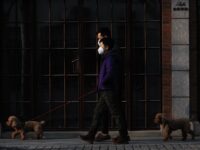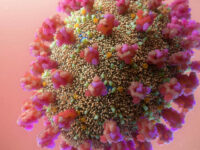We are all avoiding public spaces and participating in “social distancing” to curb the spread of COVID-19, the novel coronavirus at the center of the current pandemic. Guidelines on how to protect oneself and others vary between every authority. Initially, the Centers for Disease Control and Prevention (CDC) recommended that people not wear masks and then switched its stance causing many businesses to require them. In Massachusetts, you can now be refused service or fined if you do not wear a mask in a public place where social distancing is not possible. This raises the question though, what is the science behind these decisions? Obviously, this is a very new situation, and the information is developing every day. However, examining how the virus spreads and the fluid mechanics of a sneeze can tell us a lot about the effectiveness of social distancing and wearing a mask.
Firstly, the most important thing to understand is how the virus spreads. According to information from the CDC, the virus transfers person to person through “respiratory droplets.” This means a simple handshake won’t transfer the disease. However, if a person had touched their face or even breathed close to their hand before the handshake, the virus could be on their hand and spread. Any time a respiratory droplet is released from an infected person, there is a risk of infection. This is where physics and fluid dynamics come into play. How respiratory droplets travel through the air dictates the standards set to protect everyone.
This is a very new situation, and the information is developing every day. However, examining how the virus spreads and the fluid mechanics of a sneeze can tell us a lot about the effectiveness of social distancing and wearing a mask.
A study by Lydia Bourouiba, a researcher at MIT, found that sneezes can spew various sizes of saliva and mucus up to eight meters away. For a cough, the droplets can travel up to six meters. In addition, particles can stay in the air up to 10 minutes after their initial release. However, social distancing guidelines from the CDC state that two meters are enough to protect yourself from contamination. Likewise, The World Health Organization recommends staying only one meter is enough. Should we start staying eight meters apart from people on the streets?
There are many things we need to consider before making this determination. First, when a person is walking down the street, especially if they are asymptomatic, they will not be coughing or sneezing. If they are coughing or sneezing and direct it into their elbow, they will limit the emittance of respiratory droplets. This means that staying two meters apart isn’t necessary at all times. However, when coughing or sneezing does occur, staying eight meters away is necessary for full protection and also avoiding the area for up to ten minutes depending on the airflow.
Most large particles will not spread if the wearer has a face covering. In addition, it prevents the user from touching their mouth and nose which could spread germs on their hands.
Introducing masks to the scenario, most large particles will not spread if the wearer has a face covering. In addition, it prevents the user from touching their mouth and nose which could spread germs on their hands. Therefore, with a mask, two meters is still a good distance for protection. However, some small particles will still be able to get through the fabric.
Overall, the goal of physical distancing is to limit risk. Wearing a mask and keeping two meters away will prevent the spread of COVID-19. Washing your hands regularly and disinfecting highly touched surfaces will reduce the risk of infection. Remember, next time you mask up for that grocery trip, we are all in this together, and there will be brighter days ahead of us.
Experiments in Fluids (2015). DOI: 10.1007/s00348-015-2078-4
Journal of Fluid Mechanics (2014). DOI: 10.1017/jfm.2014.88
Image source: Pixabay.






